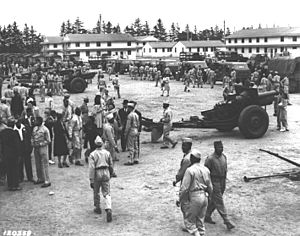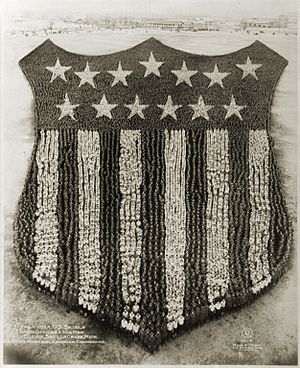Fort Custer Training Center facts for kids
Quick facts for kids Fort Custer |
|
|---|---|
| Kalamazoo County, outside of Augusta, Michigan, 4 miles west of downtown Battle Creek. |
|

184th Field Artillery at Ft. Custer (June 1941).
|
|
| Type | Army post |
| Site information | |
| Controlled by | United States |
| Site history | |
| Built | 1917 |
| In use | 1917-present |
| Battles/wars | none |
| Garrison information | |
| Past commanders |
William H. Hay LTC Dennis Nadrasik |
| Garrison | |
|
Camp Custer Veterans Administration Hospital--United States Veterans Hospital No. 100
|
|
| Location | 5500 Armstrong Rd., Battle Creek, Michigan |
| Area | 206 acres (83 ha) |
| Built by | Construction Service-VA |
| Architect | Quartermaster Corps-US Army; |
| Architectural style | Colonial Revival, Classical Revival |
| MPS | United States Second Generation Veterans Hospitals MPS |
| NRHP reference No. | 12000282 |
| Added to NRHP | May 17, 2012 |
Fort Custer Training Center, often called Fort Custer, is a training place for the Michigan Army National Guard. It's owned by the U.S. government but run by the state of Michigan. Other parts of the U.S. armed forces also use it, along with military groups from Illinois, Indiana, and Ohio.
Fort Custer is one of the busiest training sites in the Midwest. It's mainly used for small arms practice and vehicle maintenance training.
The Fort Custer Training Center is located in both Kalamazoo County, Michigan and Calhoun County, Michigan. Most of its buildings are about 4 miles (6.4 km) west of Battle Creek, Michigan. They are also about 2 miles (3.2 km) east of Augusta, Michigan.
Besides the main training center, there are other important places nearby:
- The Battle Creek VA Medical Center helps military veterans.
- Fort Custer National Cemetery is a burial ground for veterans.
- Fort Custer Recreation Area is a state park for outdoor activities.
Contents
History of Fort Custer
Building Camp Custer for World War I
Camp Custer was built in 1917. This was during World War I. It was named after General George Armstrong Custer, a famous Civil War officer.
The camp was designed to train soldiers. More than 100,000 troops trained or left the military here during World War I. This included 5,000 soldiers for the "Polar Bear Expedition." This group went to Russia as part of the Allied intervention in the Russian Civil War.
Civil engineer Samuel Arnold Greeley designed and built the camp. He finished it in just a few months. It was made to hold 35,000 men.
Between the World Wars
After World War I, the camp continued to be used. It trained members of the Officer Reserve Corps. It also trained people in the Civilian Conservation Corps. This program helped young men find work during the Great Depression.
Fort Custer in World War II
On August 17, 1940, Camp Custer became Fort Custer. This meant it was a permanent military base. During World War II, the base grew very large. It had space for many officers and thousands of soldiers.
More than 300,000 troops trained at Fort Custer during WWII. This included the 5th Infantry Division. This group went to Iceland in 1942. Later, they landed in France after D-Day in 1944. They fought in many battles, like the Battle of Metz.
In 1943, many new Army recruits came to Fort Custer. They received their gear here. Then, they were sent to basic training or other assignments. The main job of the camp was to train Military Police. Fort Custer also held about 5,000 German prisoners of war until 1945.
The Cold War Era
In 1949, the Navy Reserve started using Fort Custer. A Marine Corps Reserve unit joined in 1952. Around 17,000 troops trained here for the Korean War. Fort Custer also served as a place where new draftees joined the military.
From 1959, Fort Custer was part of the North American Air Defense system. This system protected North America from air attacks. In 1968, the state of Michigan took over running the base. However, the U.S. government still owns the land.
What Fort Custer is Used For Today
Training and Facilities
Today, the Michigan National Guard uses Fort Custer's facilities. Other parts of the armed forces also train here. This includes ROTC students and units from Ohio, Illinois, and Indiana. The 177th Regiment and other training sites are based at Fort Custer.
Even law enforcement agencies use the area. The FBI and the Michigan State Police train here.
Fort Custer has many useful facilities. It has a distance learning center for online classes. There are barracks for soldiers to stay in. Dining halls provide meals for visiting units. The training areas offer different types of land. The small arms ranges have been updated recently.
ROTC Training Exercises
ROTC cadets use Fort Custer for their "Combined Field Training Exercises" (CFTXs). These exercises happen twice a year. They include finding their way using maps, both day and night. Cadets also practice tactical situations. They work in teams with students from different schools. Their performance is graded during these exercises.
Fort Custer is being considered for a new missile defense site. This would help protect the Eastern United States.
The U.S. Navy Reserve has a center here. It's called the Navy Operational Support Center Battle Creek. It helps about 270 Navy Reserve sailors. These sailors are from Michigan and Indiana.
Beyond Military: Fort Custer's Other Uses
VA Medical Center's Role
The base was very large during World War I and II. After the wars, some land was given away. In 1923, 675 acres (2.7 km²) were given for the Battle Creek Veterans Affairs hospital.
This hospital helped soldiers who were injured in Europe. Today, the Fort Custer Veterans Affairs Hospital is well-known. It provides excellent care for veterans. This includes both in-patient and out-patient care. It especially helps veterans dealing with Post Traumatic Stress.
The hospital grounds once had a 200-acre (0.8 km²) farm. This farm was used for vocational therapy. It helped veterans learn new skills.
Fort Custer Recreation Area
The Fort Custer Recreation Area is a state park. It's about 3,000 acres (12.1 km²) in size. This land was given from the base in 1971.
The park has many trails for different activities. There are 22 miles (35 km) of hiking trails. It also has 20 miles (32 km) of mountain bike trails. Plus, there are 16 miles (26 km) of bridle trails for horses. In the winter, you can go cross-country skiing. You can also rent small cabins to stay overnight. The park is located east of Augusta on M-96.
Fort Custer Industrial Park
Battle Creek Unlimited built the Fort Custer industrial park. It has over ninety businesses. These businesses provide more than 8,000 jobs. The park was built on former base land in the 1970s. It is located between the military reserve and the W. K. Kellogg Airport.
Businesses here make many different products. These include shopping carts, noodles, fiber optic cables, traffic signals, and automotive parts. They also make water purification pumps. The industrial park is very successful. It is the largest modern industrial park in Michigan.
Fort Custer National Cemetery
The Fort Custer National Cemetery is 770 acres (3.1 km²) in size. It uses land from Fort Custer and the VA Medical Center. As of 1999, over 11,955 people were buried there. The U.S. Department of Veterans Affairs believes the cemetery has enough space for burials until after the year 2030.
Images for kids



